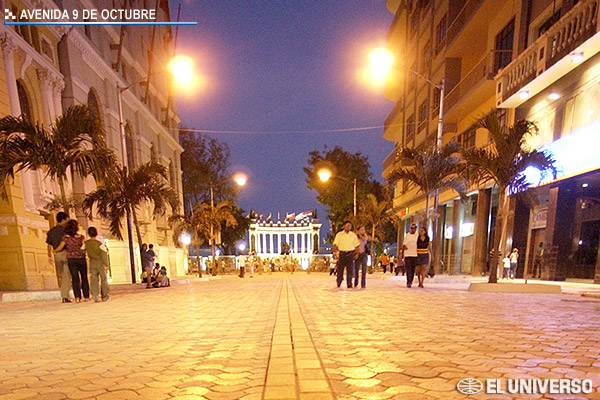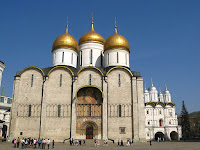
THE KREMLIN, IN MOSCOW MAY 2, 2011
On May 2, we started our last day in Moscow. Riding the same buses we had ridden for the previous three days, we headed to the Kremlin, the site of the heart and soul of the government of the powerful Russian Federation, we passed by the enormous, grayish building where the Russian Federation´s (Duma) congress meets, the Bolshoi´s ballet, and across it the monument to Karl Marx, the main brain of the Communist Ideology. I was glad to see that in behalf of billions of people around the free world, a group of pigeons were sitting on Marx´s head and shoulders, and they were happily depositing their digested food in the right place. By 10:30 A.M, we were making a line to enter into the most famous historical site of Russia, THE KREMLIN.
By 11:00 in the morning, we entered into this vast complex of historical many government buildings, cathedrals, churches, monuments and museums, constituting the entrails of the giant Russian bear.

THE KREMLIN´S BAND, CHANGING
GUARD AT 11:00 ON MAY 2, 2011
As we entered the complex, a large number of Kremlin Guards was leaving the area after completing their time on guard. May 2 was a normal working day in Moscow, after a long three day holiday, so, at the interior of those enormous buildings, the Russian government´s machine must have been busily working in business as usual, while we, a group of 156 tourists coming from the United States of America, were looking at everything with the natural curiosity and amazement of someone who is visiting a very important place for the first time.

THE YELLOW AND WHITE GOVENRNMENT
BUIKLDINGS WITHIN THE KREMLIN
I could not avoid thinking that nothing like this could have occurred only 25 years ago, when most Americans in Russia were seen as CIA spies if they were holding a camera, just as most Russians were seen in America as KGB spies. Well, those were the past days of the cold war, and I was very happy to be living this moment and enjoying every bit of it. After every step we took there seemed to appear a new great scenario for a new photo, and I could not keep pace with my wife and the other members of our group who were walking not very close behind our guides.
Our guide, Alexander, explained to us that the word Kremlin, in the Russian language means “refuge” or “fortress to protect a city from its potential and real enemies”, and that there are many “Kremlins” in Russia, although none of them is as famous and important to Russian History as the Moscow Kremlin. We were explained that Russians, who have been historically a people at war with its neighbors from all sides, used to build these fortresses wherever they felt they were menaced by their enemies and that the Moscow Kremlin, was built in the twelfth century after a hunting feast held atop a hill looking at the Moscow and Neglina Rivers within the dominions of Prince Yuri Dolgoruki, who was fighting the Mongol Empire which dominated vast Russian areas of what is now the immense Russian territory. That day, Yuri and his commanders decided that this was a perfect place to build a Kremlin, and so they did. Within a century, the town had risen to become an independent principality within the Mongol empire, and by the middle of the 14th century; its princes had gained such pre-eminence that Moscow was made the site of the Russian Orthodox Church and the center of the United Russian Empire.
It was under Tsar Ivan the Great, at the end of the 15th century, that Muscovite rule extended over all of Russia, so ending three hundred years of Mongol dominance, and the Kremlin gained its role as the seat of Russian power, until Peter the Great transferred the capital of Russia to St. Petersburg a city he started from zero in what it was an enormous marshland. For centuries, then, the Kremlin served as the central stage for the magnificent and occasionally horrific history of the Tsars.
When the Bolsheviks chose Moscow as their capital in March 1918, the Moscow Kremlin returned it to preeminence, and during Soviet rule the Kremlin experienced its second life as a great center of power. Although the Soviet state certainly left its mark on the Kremlin, the centuries-old citadel very much retains the aura of early Tsarist Russia, especially in Cathedral (Red) Square, where the spirits of Ivan the Terrible, Boris Godunov, and the early Romanovs loom much larger than those of Stalin or even Lenin himself.
THE ASSUMPTION CATHEDRAL, WHERE THE
CORONATION OF THE TZARS USED TO TAKE PLACE
The magnificent Assumption Cathedral within the Kremlin walls, which was, for centuries, the site of the coronation of Russian Tsars is one of the most important icons of the Russian history. It was, just as most buildings within the Kremlin, completely destroyed by the French forces under Napoleon, before they left Moscow in full retreat, pursued by the Russian Army under the command of Marshall Mikhail Kutuzov in October of 1812.
As we extended our visit to this much historical places, I felt that I was going through history myself, at certain moments I felt like I was living the events that had taken place several centuries ago. I was, and I still am, fascinated by what I saw and heard. Entering the Cathedral where the coronation of the powerful Russian Tsars used to take place and looking at the chair where they used to take the oath of office, as it was so close to me, made me think of how ambivalent life can be. One moment, a man can be as powerful as a Russian Tsar, the undisputed master of life and land, and sooner or later that same man can be as insignificant as the ashes of any man in his tomb. I couldn´t help but think that we, all men and women, should act in our lives as if we knew we would be remembered only by those acts in our life which positively affect the lives of those around us, be them family, friends, community, country or the human kind. We all might be better as individuals if we could remember we are mortals and that eventually we will become just ashes in the wind.

THE LARGEST CANNON EVER BUILT
IT NEVER, EVER, SHOT A BULLET
We saw within the Kremlin, and took photos of the largest cannon that were ever built; a cannon that was ordered by Tsarina Catherine I, the daughter of Peter The Great in 1726, and that never ever shut a shot, because it was so big, there was no way to find the power to make it shoot a bullet. We saw within the Kremlin many of the Russian Executive branches of government, all of them painted in light yellow and white

THE LUXURIOUS CARRIAGES OF THE TZARS AS
EXHIBITED IN THE KREMLIN´S MUSEUM
We visited the Armory Chamber which preserves ancient state regalia, ceremonial Tsar’s vestments and Tsarinas´ unparalleled coronation dresses, vestments of the Russian Orthodox Church’s hierarchs, the largest collection of gold and silverware by Russian craftsmen, West European artistic silver, ceremonial weapons and arms, royal carriages and horse ceremonial harnesses.

ONE OF THE DRESSES OF CATHERINE
THE GREAT AS EXHIBITED IN THE KREMLIN
At 2:00 o´clock we completed our visit of the Kremlin; we had been into, and seen it from the inside, the very entrails of the giant bear. I never, ever, not even in my wildest dreams, had thought that I was going to be there. We came out fascinated from all we had seen and as we left the Kremlin from the Southern side, we saw the beautiful Moscow River and dozens of mid size vessels full all tourists navigating the Moskva River and viewing the Kremlin wall from the outside, in this sunny, magic, splendorous Spring day, in which Moscow was saying good bye to us and we were saying good bye to Moscow, as we were heading to the pier in a Moscow suburb where we were to board the Leo Tolstoy, the vessels in which we were set to navigate the Volga River, towards our next destination, the beautiful, the royal, the majestic, the unparalleled St. Petersburg.
In my next posting: NAVIGATING THE VOLGA















